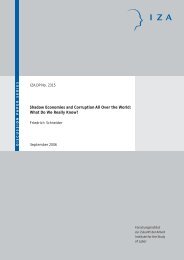Immigration: High Skilled vs. Low Skilled Labor? - Iza
Immigration: High Skilled vs. Low Skilled Labor? - Iza
Immigration: High Skilled vs. Low Skilled Labor? - Iza
Create successful ePaper yourself
Turn your PDF publications into a flip-book with our unique Google optimized e-Paper software.
Furthermore, even low-skilled workers are often forward looking and consider the educational<br />
and employment opportunities that will be available for their children.<br />
VI. Patterns of Adjustment<br />
It is important to recognize that high-skilled immigrants have a different pattern of<br />
economic adjustment than low-skilled immigrants. For those with a low occupational attainment<br />
prior to migration there is little scope for occupational mobility after migration. Although their<br />
specific or narrowly defined occupation may change, they are likely to remain at a comparable<br />
occupational level and experience little occupational upgrading with time in the destination.<br />
Among high-skilled immigrants, however, two distinct patterns to their adjustment may<br />
be observed. If the immigrants come from countries with a similar level of economic<br />
development, the same language and similar educational systems and labor market institutions,<br />
in the absence of occupational licensing, the immigrants’ skills are likely to be very highly<br />
transferable to the destination labor market. In this case the migration is likely to be between<br />
two high-income countries and is not likely to occur unless the potential migrant receives a high<br />
wage offer for work in a comparable job or occupation. Then, with the passage of time the<br />
immigrant is likely to experience a relative decline in earnings (“regression to the mean”) even if<br />
there is no change in occupational status. This pattern has been found among countries for<br />
which there is a high degree of skill transferability, such as among the English-speaking<br />
developed countries (Chiswick and Miller, 2011b).<br />
In the more common scenario, however, the high level of skills is not perfectly<br />
transferable. In this case the immigrant initially experiences downward occupational mobility<br />
compared to the origin, to be followed by upward earnings and occupational mobility as the pre-<br />
11
















